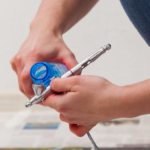If you want to post a great picture of yourself on social media, I mean the kind of picture that will make you look like a rockstar and turn heads and command the attention of friends and family, funneling in a wave of likes, or maybe waves of matches on online dating apps.
Well, to get that kind of picture, almost everyone is using photo editing and post-production.
Back in the day, if you wanted to get high-grade images, like of the models on magazine covers, you had to get a professional to do it.
Nowadays you don’t have to look too far to make great edits. Apps like Face Tune can make a huge difference to your selfies and it doesn’t even look that weird!
Despite the amazing strides in accessible, photo editing technology, airbrushing images has created a fair bit of hubbub in the public discourse.
As a whole, airbrushing photos in magazines has garnered more negative than positive feedback for its practice. The controversy surrounds a concern for the establishment of unrealistic beauty standards which fuel negative body image. However, the attractiveness of airbrushed photos is undeniable, so it remains a common practice in publishing and advertising.
Simply, there is pressure from concerned people looking at the negative effects of airbrushing images, but because it works for the magazine publishers’ purposes, it remains a common practice.
To get to the bottom of the airbrushing issue, let’s take a look at what airbrushing in magazines is, why magazine publishers use it, and the real reason’s behind its controversy.

What is Airbrushing in Magazines
Airbrushing in magazines involves using computer programs to edit subjects’ appearances in photos. This typically involves smoothing out their skin and hair, elongating limbs, and slimming out their physique.
This kind of post-production editing resembles airbrush painting in real life. This is because the atomized stream of paint produces a smooth finish that blends well on the substrate.
Nowadays, the editing is done with programs that mimic a real-life airbrush. The user can use a “virtual” airbrush to touch up and smooth out the photo on a computer screen instead of on a physical canvas.
Here’s a video that gives a good overview of how to do a basic airbrush job on an image of a girl’s face:
Why Magazine Publishers Airbrush Photos | Pros
Think about it, they have the power to fix an anomaly in their images, including model’s features – why wouldn’t they use that power?
Magazine publishers are motivated to release publications that attract eyeballs. These publishers have been around long enough, and enough experiments have been done to know what attracts the average person’s gaze and what doesn’t.
Simply put, magazine publishers use airbrushing because it works.
Think about it, they have the power fix an anomaly in their images, including model’s features – why wouldn’t they use that power?
The uncomfortable truth is that humans are mammals that have biological desires. Our mammalian brains are wired up to be attracted to sexually pleasing stimuli. When we see a sexually attractive person, our body reacts without our conscious control.
That magazine with an airbrushed model on the front catches our gaze and gives the magazine an opportunity to capture our attention.
This is especially true for men who have a higher proponent of their sex drive activated by visual attractiveness than for women.
It’s not a secret that sex sells, and when magazine publishers are all doing it, no one wants to lose their competitive edge. But with pressure from advocacy groups and research indicating negative mental health repercussions, airbrushing has taken some heat in the public sphere.
Why Airbrushing in Magazines is Controversial | Cons

Airbrushing in magazines is controversial because of the negative mental health effects attributed to its widespread usage.
The idea is that when every image that is presented in mainstream magazines has an impossibly beautiful figure on it, it is demoralizing on a subconscious level. This phenomenon is especially true for the female population.
There’s lots of evidence to back up this claim. In this study on the effect of western beauty ideals, a survey of 3300 women aged 15 to 64 reported that 67% withdrew from life-engaging activities because they felt bad about their immutable appearance.
Parallel to airbrushing in magazines is the “social-media-model” phenomenon which also involves dramatic changes to images to capture and monetize views. Research conducted by Johnathan Haidt and Greg Lukianoff gives light to a disturbing increase in anxiety and self-harm in teen girls perpetrated by unachievable beauty standards presented in social media.
Some big brands and publishers have pledged to “reduce” airbrushing in magazines, but there is no oversight to manage the extent of these edits and their subsequent effect on viewers.
At the end of the day, airbrushing in magazines seems like it’s here to stay. We know that there is a correlation to unrealistic beauty standards with negative mental health, but does that tell the whole story?
In an age where media companies are extremely good at manipulating the truth with slick editing techniques, and there is a race to the top to get the most views – is it really a surprise to people that magazines touch up their images?
The way that media is affecting children is very creepy I will admit.
But as responsible adults, maybe people need to be aware of the effect these images and media have on their subconscious and react accordingly. And in kind, be responsible for teaching their children to derive worth internally instead of from external sources.
Just throwing some ideas out there, what do I know, I’m just an airbrush artist that wanted to learn more about this issue and share my opinion on it. I hope this article has given you a good rundown on some of the pros and cons of airbrushing in magazines.
Until next time, keep on painting!


